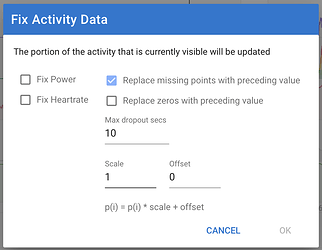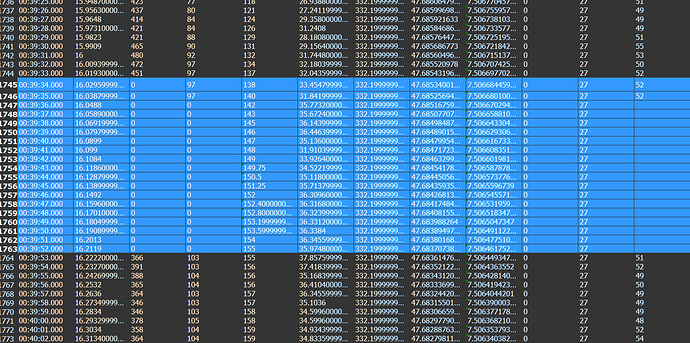You can use the “Fix data” option under the ride timeline chart to scale the power for a ride. I am going to add support for different FTP for different bikes soon and will look at also adding “y=mx+c” function to each bike for power at the same time.
Just out of curiosity: why? If you ride any of your bikes equally often, I don’t see why there would be a difference.
I suppose that if you hardly ride one, you may have a difference, for instance between a TT and a ‘normal’ bike, but otherwise…
The TT vs normal bike is one reason. Another is to handle power meters returning different numbers. Having different FTP’s gets the intensity and training load right without having to change the power data.
Which is why I have easy to swap pedals - if you have two or more bikes, why have different power meters.
Out- versus indoor, i.e. with a smart trainer, that would make more sense, although I frequently swap the pedals to that bike too, just to check accuracy between them.
Having a different FTP for a different bike, or for indoor training, is actually not that much related to you actually having another FTP.
It’s more about other factors, different circumstances, for which you can train to even those out.
Anyway, as always, this is going to be another option that one can either use, or not 
Plenty of reasons: You might like Speedplay, Shimano or Time pedals, or ride a mountain bike where crank or hub based power meters are currently the only real option.
Mike
I have a mountain bike and I’m using the same pedals - I get it that most do not favor Look or SPD-SL for a MTB, but I got used to that too.
Then again, I don’t MTB that much and probably not on the very serious courses that I sometimes see others ride…
Fantastic!
Mike_Lauder: actually there is an assioma hack that enables you to fit the pedal power meter to mtb pedals. See TR forum, or gplama.
I’m aware of the assioma hack as I was the one that came up with it. Still not a great solution for real mountain biking though as the pods are a bit exposed on the ends of the cranks. Fine for gravel I guess, although I tend to use road pedals if I know I’m not going to be walking.
Mike
BTW, is there a way to discriminate between actual coasting (0 W data points) and loss of connection between the PM and the recording device? It seems my Rotor INspider loses the connection rather frequently for a few seconds up to half a minute. For Strava, these events are recorded as 0 W/coasting and hence the avg power is reduced. In the attached screenshot, the cursor is positioned in one of these 30 s windows with no connection to the pm. I know about the data correction tool on intervals.icu. But how do I know if I actually stopped pedaling or the connection was just lost? (In this case, it was easy, since the route was flat. And I can hardly go 38 kph for 30s without pedaling.) 
Is there no difference between null and 0 on the graph? Null being ‘no data’ and 0 meaning 0 Watts 
In the fit file, there is a “0”. Interestingly, the first 3 seconds when connection was lost, there are still non-zero cadence values in the file (99 rpm). This seems to be a pattern. I found another 20 s gap in the same file. Speed an HR are actually increasing, while the power and cadence values are 0. Also note the non-integer HR values. 
EDIT:
They should indeed change the standard for recording data. If the connection to a a sensor drops, there should be a -1 or a string instead of a zero. This would simplify data processing/curation.
Please post a link to that activity on Intervals.icu and I can have a look. I have seen data from Strava with “null” for missing data points rather than zero. Intervals.icu does distinguish in its “fix data” function (“missing data points” are the nulls).
Interesting. Maybe different devices record it differently. I’m using a Fenix 3. … Anyway, here is the link: https://intervals.icu/activities/3949754876
It’s zeros unfortunately. My PowerTap hub and Edge 500 occasionally drop data points and these show up as nulls and not zero. So as you suggest its probably PM and head unit dependent.
Thanks, David. I will probably replace the PM. I have virtually no dropouts with the INpower on my road bike. It’s only the INspider causing trouble. Maybe I switch to power2max. It would be compatible with the Aldhu cranks.
Hi David. Recorded my last ride with a fenix 5. Interestingly, this watch seems to record blanks for dropouts according to the tcx file (while the f3 recorded 0 Watts in this case). However, when I inspect the fit file with GoldenCheetah, there are 0s in the power field. Not sure which format is exchanged between Garmin Connect, Strava and Intervals.icu, but when I use the fix data tool here to replace blanks, it doesn’t seem to change anything.
You could use the replace zeros option. Intervals.icu doesn’t get the raw files from Strava, only the individual traces.
Since this post started discussing the fluctuations in the signal for powermeters, I have noticed sometimes the signal on strava for high endurance rides if the guy is super strong looks like smoothed out or something, any guesses on what it is?
That depends and ‘super strong’ may have less to do with it than being able to pedal consistently.
Was it indoors or outdoors? Indoors, you can set your trainer to a fixed Watts output, by using a phone app via BLE and ride a virtual course using the Ant+ channel on a desktop app.
I routinely do that.
Outdoors, if you have long, flat straights, like I do in my area, you can achieve a similar curve - or lack thereof - by turning the pedals consistently. I have lots of examples of that as well.

